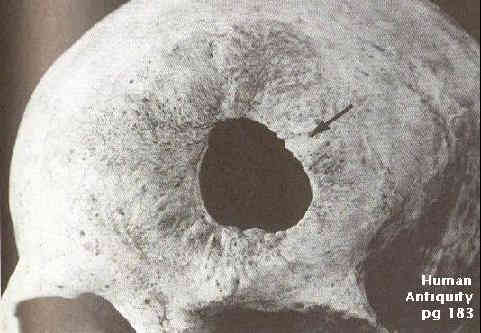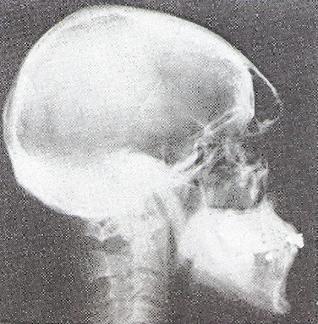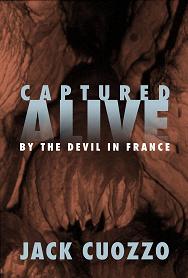

This page will examine the remains of "Rhodesian man" from Broken Hill in Zambia.

|
In 1921, Tom Zwigelaar found an adult cranium in Kawbe, Zambia. (pg 208, Donald Johanson, "From Lucy to Language")
This skull known as "Broken Hill 1" is classified as Homo Heidelbergensis. Is the Broken Hill skull actually human? If so, why does it look so odd? Dr. Cuozzo's original research on the Broken Hill skull has revealed that this is actually the skull of a modern human who suffered from acromegaly. |

| The "Broken Hill" skull has 2 rather odd shaped holes in its cranium. Previously these had been attributed to a process called trephining. Trephining is a practice by which a hole would be carved in the skull of a living person. This is done as part of a ritual that they believe releases evil spirits. Here is a picture of a modern skull with holes from trephening. |
 |
Are the holes in the "Broken Hill" skull evidence of trephining - or are they something more?

In his book "Buried Alive - the Startling Truth about Neanderthal man" Dr. Jack Cuozzo tells of his work on the "Broken Hill" skull.
Dr. Cuozzo believes this is actually a modern skull, which was deformed from a disease, and the 2 holes are actually entrance and exit wounds of a bullet.

Here is a chapter from his book:

Chapter 16 of "Buried Alive: The startling truth about Neanderthal man"
By Dr. Jack Cuozzo
Master books 1998
This chapter Reprinted with permission.
Two Bullet Holes and a Disease.
"My objectives started to become clearer in the British Museum. In France we were captivated by our presence amongst the relics of ancient history and tense because of the enormous task at hand. In England some of the fascination and tenseness started to wear off, for we knew we were doing this tor a second time. We also were better organized. I began to get more ideas about what the term "NeanderthalĒ meant and because of this I knew more about what I was looking for in the fossils.í
I started to get the eerie feeling that many things had been changed to show what they wanted to show. I began to see more evidence that the Bible was accurate in its description of ancient man.
We were able to photograph, x-ray, and study some of the most famous fossils from three continents: from Zambia. Africa, the Broken Hill or Rhodesian Man Skull, without a lower jaw: from the Middle East. Israel. Tabun C-I. found in one of the Mount Cannel caves; from the Island of Gibraltar. at the mouth of the Mediterranean Sea, Gibraltar I and II, a female adult Neanderthal and a Neanderthal child. For some unknown reason, however, I was not allowed to see the Gibraltar II bones of the side of the head or the ear bones. The real shocker came. I must admit, when I was caught by surprise because of one of their prized possessions. It was the Broken Hill skull from Zambia.
It's not as if there were no holes or broken parts of the other Neanderthal skulls: there were. This hole was different. It appears on the outside of the skull and is wider than it is high. However, the cephalometric radiograph revealed an almost round hole. Its measurements on the radiograph (slight distortion) were 7.7 mm wide by 8.0 mm high. Allowing 4% foreshortening because of the angulation of the temporal bone from the radiographic plate, it is very close to 8mm by 8mm round. It was very suspicious. It appeared as if it were made
deliberately, but not by the old process of trephining.
Trephining is probably one of the oldest operations performed by man on the skull. It consisted of making a rectangular-shaped hole in the head and skull for various reasons, medical or superstitious, either before or after death. Sometimes a rounded hole was made. This Zambian hole is different
for two reasons.
First, there is another hole in
the back part of the bottom (occipital bone) of the skull, well inside the neck area where no trepanning dur-ing life is possible. This second hole is not the foramen magnum, where the spinal column enters the skull. The second hole in the bottom part is also much larger than the first hole.
In any event, I saw no evidence of healing of the bone around the entrance hole, which if present would mean an operation produced this defect during
a lifetime, with some recovery later. The raised lip on the outer and lower surface of the entrance hole in the temporal bone has two distinct cracks
(splits) which is not characteristic of healing.
Also, Oakley reports in 1958 that the cave in which this fossil was found contained no extinct species of any mammal but one, and he thought it was pos-sible but doubtful.(4) Cooke, in 1964, reports on most of the fossils being from living species with only two of them from extinct species.(5)
Because of the dubious nature of extinct fossils in the cave, my guess is that the skull
is of recent origin with a bullet entry and exit holes. One other author mentions
this possibility.(6)
What then is the explanation for the Neanderthal-like morphology (bony characteristics) of the skull?
Some say that the features are like modem Homo sapiens in some areas.
(7) Campbell, in 1964. labeled it Homo sapiens rhodesiensis.(8)
The lateral view radiograph (figure 10) shows an enlarged and flattened turkish saddle (sella turcica) or pituitary fossa, the site of the pituitary gland in the middle of the skull. Figure 11, a posterior-anterior view of the skull, shows many air
pockets (excessive pneumatization) in the forehead (frontal) and other
paranasal sinuses of the head and similar large air pocket formations in the mastoid process on the left side.
The British museum people told me that no lower jaw was found with the skull.
This seemed to be very unfortunate because the lower jaw is important in diagnosing certain diseases of the bones of the head. You must understand that this skull really cries out disease. Most of the teeth are badly decayed, and the bones of the vault of the skull are extremely thick. The base of the occipital bone is 8mm thick. Normally this area is close to 6mm or less.(9) From the lateral cephalometric radiograph we see that the upper part of the occipital bone is 13.8mm. This is far from normal.
The lateral radiograph view, figure 10, also displays the external occipital protuberance (pointed bone on the back of the skull). This pointed projection of the occipital bone appears to have been flattened even though most of the right side of the cranium has been damaged and is missing. Most of the right side has been replaced with an artificial section including pad of the external occipital protuberance. Both frontal and side view x-rays show extremely thickened tables of bone which form the outline of the skull.
There are many features that testify to a diagnosis of acromegaly or excess secretion of growth hormone in adulthood, as seen in modem humans who exhibit most of these same features.(10) It seems that the Broken Hill skull from Zambia, being found without a lower jaw and having a chopped-off or broken-off mastoid process, could very well be an example of a Homo sapiens with acromegaly, a disease of the pituitary gland which produced all these bony changes. The lower jaw would have been a key factor in this diagnosis. If it was really long and its teeth were far in front of the teeth of the upper jaw when the jaws come together in occlusion, the bone under the lower front teeth would be very, very thin. If this had been found with the skull, it would have been a substantial piece of the Broken Hill diagnosis. The most incriminating factor is the broken-off, mastoid process on the left side. These are very elongated in acromegalic persons. This looks very suspicious.
A further observation about the lateral radiograph is in order. There was an-other radiographic side view of the Rhodesian (Broken Hill) man cranium published in 1958 by R. Singer of Capetown, South Africa.(11) It was interesting because it was published as a negative and not a positive print of the radiograph. Why was
this done? In a negative ra-diograph all the white bony parts are black instead of white and all the space around the skull is white in-stead of black. In Singerís negative the entrance bullet
should have been white with the surrounding bone shades of gray and black. But in Singerís negative there is no bullet hole at all. The inside of the cranial cavity is all grayish, so the bullet hole is erased.
I am not accusing the present staff of the British Museum with this because it probably goes back to the late fifties and early sixties when someone knew they needed a little extra proof against pituitary disease. The amazing thing is that this skull is supposed to be 200 thousand years old.(12)
What follows below is not part of Dr. Cuozzo's book, but rather Chris Stringers response to Dr. Cuozzo's finds.
"I have been investigating Dr Cuozzo's charges about falsification of the Broken Hill skull, and there appears to be no scientific basis for them. The anterior clinoid process was described as present by Pycraft in the 1928 monograph. Its presence is reflected on the Elliott Smith endocast made at that time and this endocast appears to show the same anterior endocranial morphology as is preserved on endocasts made in the last 25 years. Moreover, it is present in radiographs taken prior to 1958, and after 1958. The relevant materials are curated here and have been available for inspection by researchers, including Dr Cuozzo. Therefore there seems to be no evidence that anyone falsified the presence or absence of this feature (in addition, does Dr Cuozzo have any evidence that anyone ever tried to exploit the supposed falsification?). Its absence on the radiograph published in 1958 must therefore be apparent, not real (i.e. it does not show on the radiograph, perhaps because of the exposure needed to penetrate the heavily mineralised bone or the fact that the published radiograph is a print, not an original).
"Regarding the "missing bone" from the mastoid process, I am not sure what the accusation is here, but this area has been described, photographed, radiographed and replicated on various occasions since the discovery in 1921 (see, for example, Montgomery, P.Q., Williams, H.O.L., Reading, N. and Stringer, C.B. 1994. An Assessment of the Temporal Bone Lesions of the Broken Hill Cranium. Journal of Archaeological Science, 21:331-337)."
A less mineralized bone points to a bone different from the rest in the skull. If it were an addition of a less mineralized piece of bone to the previously heavily mineralized nub of bone seen in the 1958 x-ray, one might think that this is the way it would appear.
My Fig 14 here on the website does seem to
show an anterior clinoid process of two different pieces, with a little separation in the middle, one very white(more mineralized) and one less white
(less mineralized).
"Arthur Keith published a famous example [of an acromegalic skull] around 1910, with illustrations... It looks nothing like Broken Hill,however."
Here is a diagram sent by Dr. Stringer of an acromegalic skull.
Just as there are various degrees of fossilization, there are degrees of disease.
There are many stages to acromegaly as you might know. Chris Stringer usually refers to early stages in our debate on the Broken Hill Skull, however, Broken Hill is a rather late stage [of this disease], so more accentuated in features.
The best info on this disease is on Medline which is accessible through University and Hospital systems.
Click HERE to go to the Main Subject Index

At first Bob and Chris didnít think that we could penetrate the Zambian fossil with our x-rays because it was permeated with lead and zinc. It had been
found in a lead and zinc mine in 1921. It had a very strange, almost symmetrical hole in the left side of the head (temporal bone. squama) (see figure 7).

In figure 8 a steel rod passes between the two holes. What process could have produced these holes? It Looked as if it had been made by a high velocity projectile, a bullet. Second, the first hole in the side of the head is larger inside the skull (brain side) than on the outside. It also has a bevel.


Figure 9 displays this feature. This fits the description of an entry point for a bullet.(3) Someone may have used it for target practice but this might have shattered a dry fossil, or the bullet could
have actually killed this person. The fact that it was found 60 feet down in the mine mitigates against a "target practice" explanation.

Figure 10. Lateral ceph x-ray of Broken Hill Man. Black arrow points to the former seat of the pituitary gland White arrow is on the occipital protuberance.
Figure 11. PA x-ray of Broken Hill Note extensive sinus formation (empty spaces), also permeation of lead and zinc from the mine (solid white).

Figure 12 shows that this
one remaining left mastoid process has been broken off or chopped off short of its full length.

More crucially, in Singerís radiograph the anterior clinoid process is very short (figure 13). In my radiograph it is clearly seen and even undercut with a space.

Figure 14 shows a close-up view of the anterior clinoid process in my photograph. Could this be a new addition since Singerís radiograph was taken or is his radiograph just of poor quality? If it truly is an addition to make the sella space look smaller, this little piece of bone would extinguish any
thoughts of a pathological pituitary gland as seen in acromegaly. This would be serious tampering of a skull.


Response from Chris Stringer
-Chris Stringer
Thu, 28 Jun 2001

All the heavily mineralized bone shows up as black on the x-ray in 1958. (Opposite of most x-rays today) The thin bone is white. It could not be because it was too heavily mineralized to show up ...because the x-rays would not have penetrated it and therefore it would have been "black". Only if it were less mineralized than the rest of the skull would it not have shown up
on a poorly taken x-ray. In x-ray terms, it would have "burned out" .
Dr. Cuozzo 

Chris Stringer
4/7/01


 Here is a photo of an actual acromegalic skull. This skull is not as advanced as that in the Broken Hill skull but you can see the pathology. Compare it to the x-ray of the Broken Hill skull seen here.
Here is a photo of an actual acromegalic skull. This skull is not as advanced as that in the Broken Hill skull but you can see the pathology. Compare it to the x-ray of the Broken Hill skull seen here. 


Purchase Dr. Cuozzo's books online. Available now Dr. Cuozzo's new book: "Captured Alive: By the Devil in France" (December 2003) In addition to Dr. Cuozzo's other books
("Buried Alive: The Startling Truth about Neanderthal Man"? and others)
